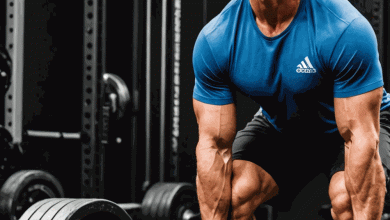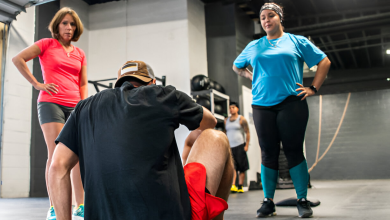Best Foam Roller For Runners
We may earn money or products from the companies mentioned in this post.
Do you love running? Do you often do it excessively that you need to massage your muscles after? Then you need a foam roller as it can help you perform the massage more efficiently. So, what is the best foam roller for runners like you?
Foam rollers differ in design, size, firmness and texture. Some are also more portable, durable and feature trigger-point design. The best ones are ideal for deep-tissue massage.
| Image | Title | Price | Prime | Buy |
|---|---|---|---|---|
| TriggerPoint GRID Foam Roller with Free Online Instructional Videos, Original (13-inch), Pink | PrimeEligible | Learn More at Amazon | ||
| YUFENGGF USA Foam Roller, Extra Firm High Density Foam Rollers for Exercise – 36 inch Black & Blue (2.8lbs/ft³ Density) with 3 Year Warranty | PrimeEligible | Learn More at Amazon | ||
| WODFitters Foam Roller with Dual Surface for Effective Trigger Point Massage and Muscle Recovery Even After The Toughest Exercises, Workouts and WODs – with Free Carrying Bag | PrimeEligible | Learn More at Amazon | ||
| VIBRA Vibrating Foam Roller – Next Generation Electric Foam Roller with 5 Speeds Settings | Includes Carry Case & Vibration Foam Rolling Training (Black) | PrimeEligible | Learn More at Amazon |
Prices and images pulled from the Amazon Product Advertising API on:
Easy Navigation
Foam Roller for Runners Reviews
TriggerPoint GRID Foam Roller
TriggerPoint GRID Foam Roller with Free Online Instructional Videos, Original (13-inch), Pink
- Patented foam roller design offers a superior, multi-density exterior constructed over a rigid, hollow core
- Constructed from quality materials that won’t break down or lose shape from repeated use
- Includes access to free online instructional video library on foam rolling best practices from the experts at TriggerPoint
- Trusted foam roller of physical and massage therapists, coaches, trainers and athletes provides muscle recovery, pain relief and improved flexibility
- Original GRID: Standard density, 13 x 5.5 inches, 500 pound weight limit; 1 year manufacturers warranty
Prices pulled from the Amazon Product Advertising API on:
Product prices and availability are accurate as of the date/time indicated and are subject to change. Any price and availability information displayed on [relevant Amazon Site(s), as applicable] at the time of purchase will apply to the purchase of this product.
The TriggerPoint GRID is a durable foam roller built from quality materials that won’t break down from repeated use. It helps loosen up tight muscles and decreases muscle and joint pain. It also helps to maximize the flow of blood and oxygen to heal tissue.
Are you a boxer? Try our best running program for boxers.
Extra Firm High Density Rollers by USA Foam Rollers
- 36 inch – EXTRA FIRM foam roller – 2.8 lbs. per cubic foot density (2.8lbs/ft³ Density) – SUPER HIGH DENSITY Foam Roller with Molded Polypropylene Foam Technology. EXTRA FIRM FOAM ROLLER: One of the Firmest foam rollers on the market – will not lose its s
- BEST Foam Rollers for Muscles – Foam Rolling with your own body weight for Self-Myofascial Release to release muscle tightness. Use a Foam Muscle Roller to help relieve Muscle Tension.
- NEW COLOR Roller – 36 inch Black Foam roller with added Blue color for a New Look. With the speckled Blue color every 36 x 6 inch foam roller has a unique look with a smooth surface that repels liquids.
- Premium Foam Exercise Roller – Great for Foam Roller Exercises for balance, flexibility and strengthening. Great for Physical Therapy, Pilates, Yoga, before or after Exercise, and Massage Therapy.
- Full 3 Year Limited Warranty – Made in the USA – USA Foam Roller Fitness Products!
Prices pulled from the Amazon Product Advertising API on:
Product prices and availability are accurate as of the date/time indicated and are subject to change. Any price and availability information displayed on [relevant Amazon Site(s), as applicable] at the time of purchase will apply to the purchase of this product.
The extra firm high-density roller by USA Foam Rollers isa premium-grade product. It is great for balance, flexibility, and strengthening. It helps relieve muscle tension and can be used as a recovery tool after long runs. It is ideal for training recovery.
>>>> Click Here To See Customer Reviews & Current Price <<<<
WODFitters Muscle Foam Roller for Trigger Point Massage and Recovery
- INCREDIBLY EFFECTIVE RECOVERY TOOL – Cut recovery time in half and perform at your best potential with this Deluxe, High Density foam roller. The specially designed patterns allow you to reinvigorate and stimulate muscles evenly. Works well to release Tight Muscles, Scar Tissue, Adhesion and Knots.
- COMPACT, LIGHTWEIGHT, PORTABLE – At slightly under 15″ long this sleek design makes it the perfect travel roller and is easy to carry from the home to the gym. Designed for athletes that train hard and is perfect for use after high intensity exercise and cross training wods.
- STRATEGICALLY HITS YOUR TRIGGER POINTS – The WODFitters foam roller will find hidden muscle aches and pains you never even knew were there and leave you reinvigorated and feeling better than you have in years.
- HIGH DENSITY FOR DEEP TISSUE MASSAGE – This uniquely designed roller can be used injury rehabilitation, balance-improving activities, muscle strengthening exercises, postural re-alignment – hamstring, IT band, glutes, and calves as well as arms, lower back, upper back and neck. Ideal for massages at home or in the gym. The dual surface makes this roller a perfect fit for runners, yoga and Pilates practitioners, swimmers , physical therapists and their patients, cross training athletes.
- PATENTED DUAL SURFACE – The specially designed patented dual surface – smooth on one side and rigged on the other – makes this foam roller extra effective regardless the type of myofascial massage you need.
Prices pulled from the Amazon Product Advertising API on:
Product prices and availability are accurate as of the date/time indicated and are subject to change. Any price and availability information displayed on [relevant Amazon Site(s), as applicable] at the time of purchase will apply to the purchase of this product.
The Muscle foam roller by WODFitters is an efficient recovery tool for runners. It cuts recovery by half that helps you to perform better during trainings. It helps to relieve sore muscles. It is ideal for myofascial release to ease pain and muscle tension.
>>>> Click Here To See Customer Reviews & Current Price <<<<
Vibra Vibrating Roller
- ROLL OUT BETTER THAN EVER – Warm up and recover like never before with the next-generation foam roller with vibration! Powerful pulses reverberate through tight and sore muscles, thwarting tension and soreness like no regular roller ever could.
- INCREDIBLE ENGINE – Vigorous workouts require vigorous rehabilitation. Epitomie Fitness’s electric roller delivers intense vibrations with its unmatched vibration engine. Capable of up to 3600 RPM to take you from rigid to relaxed in no time!
- CUSTOMIZE YOUR TREATMENT – Restore muscles and maximize performance with the only vibration foam roller with 4 intensity settings and 1 pulsating setting! Each setting relaxes and repairs, sending vibrations deep into your muscles with every pulse!
- RELAX, IT’S RECHARGEABLE – Not only is your foam roller vibrating massager’s battery rechargeable, but it lasts for over 4 hours! It includes a USB cable, but there’s no need to pull it out just yet. The roller arrives pre-charged!
- OUR PROMISE – Hit every workout hard for life when you warm up and recover with Epitomie Fitness’s vibrating exercise roller! It comes with a lifetime guarantee, ensuring that every training session is your best one yet.
Prices pulled from the Amazon Product Advertising API on:
Product prices and availability are accurate as of the date/time indicated and are subject to change. Any price and availability information displayed on [relevant Amazon Site(s), as applicable] at the time of purchase will apply to the purchase of this product.
The Vibra foam roller is an awesome vibrating foam roller that comes with a range of speeds. Sometimes runners find that a regular foam roller doesn’t do enough to get into those hard to reach spots. For those, this vibrating roller is the way to go.
>>>> Click Here To See Customer Reviews & Current Price <<<<
FAQs About Foam Rollers
What is a foam roller? A foam roller has been recently introduced in the fitness industry as a tool for self-myofascial release (self-massaging to release trigger points/tightness of muscles). It looks like a log in thick covering for comfort with use.
How do foam rollers help runners avoid injuries? Most runners will feel pain at a certain point due to mobility or wear and tear issues. Foam rollers may help reduce pain by working on tissue quality of muscles, boosting flexibility/mobility, increasing blood flow and releasing tightness in certain body areas.
Can I use a foam roller all over my body? The answer is no. One should not foam roll a joint or a bone. Foam rolling the lower back and neck should also be avoided, as these areas are sensitive and only medical professionals are allowed to attend to them.
When should I use a foam roller? Most runners use it for warm-ups (to increase blood flow and release trigger points, which may affect running form) and cool-downs (by increasing the blood flow, it helps with recovery of the muscles).
Why does foam rolling hurt? Due to compensations of the body to forces put to it, certain imbalances, movement patterns, flexibility and posture are affected. This brings you the trigger points, which cause pain when released with a foam roller.
What happens after I foam roll? There may be some soreness to the muscles released but there should at least be a feeling of relief. One should remember to avoid excessive rigorous activities after foam rolling as it may lead to damage to muscle tissues instead of relief.
How Do I Use a Foam Roller?
You place the foam roller under the areas that you want to release/mobilize and move or roll along with that body part. Runners use it mostly with the muscles of the lower limbs. You can roll the muscles for 15 seconds up to a minute for 2-3 sets depending on your pain tolerance. One should always remember to foam roll both sides to avoid muscle imbalances.
Start on rolling with the calf: Rest the other leg on the floor and put your weight on the rolling limb. Roll from the ankle up to below the knee. You can put your leg upon the rolling one to put more pressure on it.
Rolling the ITB (iliotibial band): lie on the side with the roller just below the hip. Put your other leg on the floor and move along with your thigh. You can add pressure by stacking the other leg to the rolling one.
Rolling the quads: lie on your stomach and put the foam roller above the knee (do this one leg at a time). Other leg must be resting on the floor. Then, roll upward just below the hipbone. Add pressure by putting more bodyweight on the rolling leg.
Rolling the gluteal muscles: sit on the foam roller with your other foot placed on the opposite knee. Lean in one buttock and roll forward and backwards. Use your arms and supporting leg for pressure.
Rolling the hamstrings: place the roller under your thigh, then you will roll forward and backward up to the glutes. For beginners, you may put your other leg on the floor, and for those who want more pressure, stack your other leg up to the rolling one.
How Do Foam Rollers Work?
There are certain factors that may have caused the success of foam rollers in the fitness industry. Its users range from fitness enthusiasts up to the elites in the field. There actually hasn’t been a study that proves its efficacy, but most believe that it really helps aid in their fitness needs.
For example, it is always used during warm-ups to increase blood flow and flexibility or mobility of a certain body part which athletes/runners find very helpful for their workouts.
The mechanism as to how foam rollers increase flexibility is that rolling releases the knots/muscle tightness that causes the limited range of motion in before foam rolling.
Some even claim that foam rolling decreases muscle and joint pain, increases circulation, and cures imbalances for peak performance. However, due to lack of evidence, it is to be noted that foam rolling must be used only with proper care.
After workouts, it is always a great practice to foam roll as it is a great way to relax the muscles and do deep tissue work, which may help calm the parasympathetic nervous system.
There has been also no evidence to the claims that foam rolling does not help or even damage the system. The key to making the most out of foam rollers as of now is to follow the guidelines set by professionals who have been using this practice since the innovation of self-myofascial release.
Tips to Using a Foam Roller
Foam rolling is always best to use after workouts as a recovery method. It helps clear out inflammation caused by the muscle pumps during the workout and helps in increasing blood flow, which allows wastes produced by working out to be cleared out.
It can also be used to strengthen the glutes (the biggest muscle in the body) by doing single-leg bridges on it. Place the roller under one leg (from below the knee to the ankle) while the other leg is raised, then roll forward and backward. Do it for both sides.
A foam roller can also be used as an exercise tool. It can work the abdominals effectively and strengthen the core. A video link for exercises with a foam roller will be cited at the end of the article.
It can also be used to progress other exercises such as the pull-up. You can put the foam roller between the legs and bend it at 90 degrees to make the exercise harder.
Foam rolling can also be used with the upper extremity within the upper back muscles. It is also a great tool to increase thoracic mobility.
For increasing the thoracic mobility, lie down on the foam roller (put it within the upper back). With your hands behind the head, roll upward. It should be noted that during this movement, the glutes should stay on the floor.


